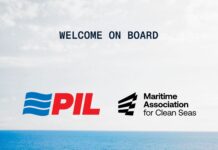
At the SMM trade fair in Hamburg, DNV and MSC signed a contract to apply the new DNV Anti-Roll Assist and ARCS (Anti-Roll for Containerships) system to 100 vessels of the Swiss/Italian liner operator.
The new contract makes MSC the first company to install the application and implement a ship-specific tool to prevent container losses due to parametric or synchronous rolling.
“At MSC the safety of our crews, vessels, and cargoes will always be our highest priority,” pointed out Giuseppe Gargiulo, head of newbuildings at MSC.
“We are always looking for new solutions to minimise risk and the new Anti-Roll Assist gives MSC a new tool that can empower our people both on-board and on-shore. By implementing the new application on our vessels captains and crew can both plan ahead and react at the moment when a potentially critical situation is identified – enhancing our safety culture. Implementing this into our current newbuildings is a natural first step and we look forward to continuing to work with DNV and build on our longstanding relationship going forward,” he said.
DNV’s new Anti-Roll Assist helps vessel captains recognise and avoid the risk of parametric and synchronous resonant rolling, through a vessel-specific hydrodynamic database, according to a statement.
Knut Ørbeck-Nilssen, CEO maritime of DNV, commented, “We are very excited about the potential of Anti-Roll Assist and the ARCS notation to help our customers enhance the safety of their cargoes and vessels.”
Anti-Roll Assist can stand alone or be integrated into other onboard systems, such as lashing computers, weather routing tools, or navigation systems. This is supported by the ARCS class notation which enables shipowners to demonstrate to their customers that a strategy to minimise the risk of container loss is in place. Owners can meet the requirements of the ARCS class notation by implementing a software solution which meets designated functional, technical and performance requirements, particularly a stringent hydrodynamic approach to calculating the risk.
“The combination of factors that lead to rolling which can result in container loss can be very hard to predict,” said Jan-Olaf Probst, director of business development in Hamburg and executive vice president at DNV.
Jan-Olaf Probst went on to explain, “In developing the Anti-Roll Assist we wanted to give captains and crews a very clear and simple picture of the risk, based on a combination of crucial factors, including their vessel’s heading and speed. The application can also support the captain and crew in assessing if a navigational adjustment is required. Additionally, through the integration of advanced weather models, Anti-Roll Assist can be used to determine the best route to avoid extreme motions during route planning, helping to optimize ship operations.”





